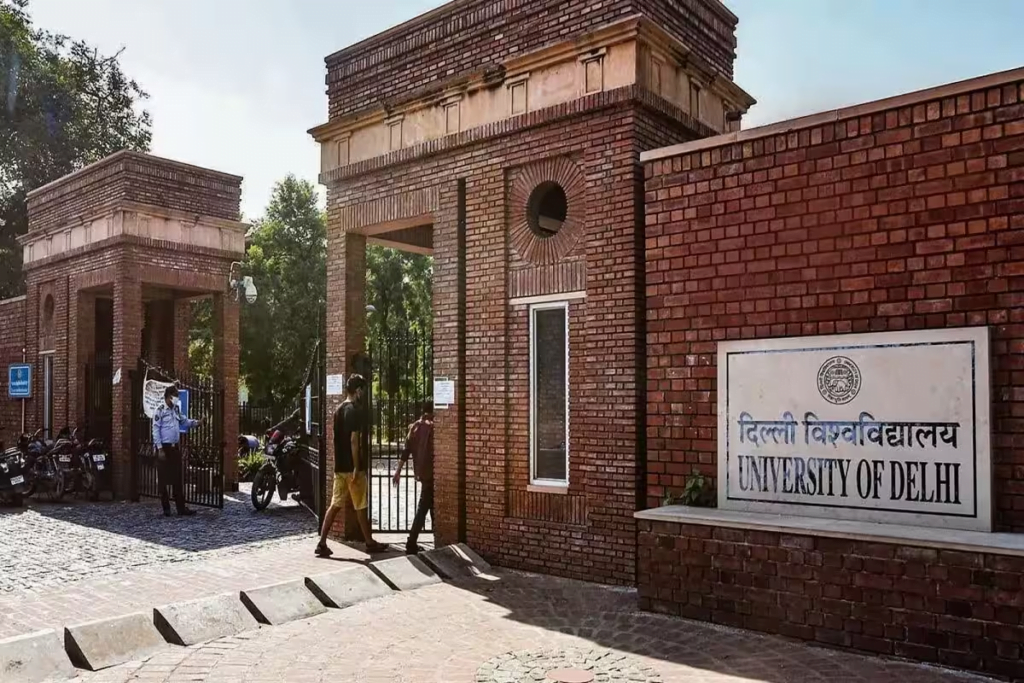The National Education Policy of 2020 (NEP 2020) is a legal framework that outlines a new vision for elementary education as well as higher and vocational studies in India. Although initiated in July 2020, it was implemented almost exactly a year back in August 2022.
As per the draft, several changes have been implemented in undergraduate courses of universities across India including changes in syllabus, evaluation and grading, in the duration of the course and through the mandate of the Common University Entrance Test (CUET).
When the Executive Council of the University of Delhi announced in late August 2021 that the NEP will come into effect in the forthcoming academic year (2022-23), the declaration was met with mixed responses. While some hailed the Undergraduate Curriculum Framework (UGCF) as a step towards increasing the employability of the students, others criticised the DU Executive Council for being hasty with their decision to implement the NEP.
The curriculum for 2022-23 was a drastic departure from the pattern followed by DU for several years. Apart from the existing Core Courses and the Ability Enhancement Courses (AEC), two new courses — the Value Addition Course (VAC) and the Skill Enhancement Course (SEC) were added to the first-year curriculum.
Although the number of core courses per semester was increased from two to three, the number of hours spent on each of them was reduced which had led to concerns of the quality of the course being compromised.

A student from the University, having completed his first year recently, spoke with FII and mentioned, ‘The core courses have been diluted and split into three from two – what previously was covered in three semesters is wrapped up in two with decreased teaching and learning hours. These additional courses are also taught by faculty who often have no idea as to what they comprise, given their focus on academic endeavours and research, not four-week workshops on Personality Development and the like.’
He also mentioned, ‘The execution of these courses also varies from college to college – it is with a certain nonchalance that conversations with batchmates from other colleges mention the absence of any of these courses in their everyday schedules, because they simply do not take place.’
Not only were the students dealt a completely different hand in terms of the curriculum and the syllabus, but the assessment pattern too was modified by the university halfway through the last academic year.
On February 3, a mere fortnight from the end of semester exams, the system of evaluation was altered to prioritise continuous assessment and tutorials. The weightage of internal assessment to theory examination for each semester which was fixed at a ratio of 30:70 was now modified to 45:55. This was after classes had already been conducted for that semester under the 30:70 assessment pattern.
When Feminism In India interviewed students regarding the matter they confessed to being caught unaware of the modification.
Benoy Thomas* mentioned, ‘The University could have waited for the next semester but it did not and demanded that additional work (for all 7 papers, alongside the already redundant projects and submissions we had finished for the 3 additional courses) be submitted while we were on our preparatory leave, studying for 7 theory exams. Naturally, most people did not put in much effort or these were not generally taken seriously by our professors.’

Another first-year student Pratap* from the University while taking to FII conveyed similar sentiments, ‘We were informed that we’d be assessed not only on our internals and class tests but also the continuous assessment (CA) which was to score us in terms of our overall performance in class and other activities throughout the semester.’
‘We didn’t know how we had been in class would be scored now. It definitely affected not only me but everyone who was assessed. It felt like we needed to be on every professor’s good side so that they’d be graceful enough to help us and not let the CA affect our CGPAs. But in the end, we had no control over what scores they gave us, so when the results came out, everyone including myself had a very hard time accepting our scores,’ he mentioned further.
What was perhaps the most obviously discernible change brought about by the NEP in the functioning of Delhi University was the centralisation of the exam that we now know as the Common University Entrance Test (CUET). The CUET is a multiple choice-based evaluation conducted by the National Testing Agency (NTA).
The university now admits undergraduate students based on merit lists created on the basis of CUET scores rather than Class 12 marks. The mandate of the CUET was proffered as a means by which the aptitude of students from different school boards could be measured by one common standardised test. The introduction of the CUET was a contentious decision for it greatly diminished the relevance of the school board examinations.
Moreover, it was feared that the CUET would lead to a boom in coaching centres tailored towards aspirants of the examinations. Coaching centres are a luxury that can be afforded only by a small section of CUET aspirants; this could worsen the already existing inequity faced by poorer students when attempting to secure a quality higher education.
The CUET last year was especially difficult for several students owing to uncertainty regarding the location of the exam centres among other things.
A DU student, Tulika*, who had appeared for the examination last year told FII, ‘Our exams kept getting rescheduled and our exams kept getting changed. For some people, the exam centre changed at the last minute and they missed their exams. My exam centre, on the first paper, was two hours away and on reaching the centre we were told that the exam had been cancelled. Even when the exams were conducted, there were many technical errors and glitches in the question papers that affected our performance in the test. On some occasions, the exams were cancelled while students were writing or even after the test had already been conducted.’

The answer keys released by the NTA following the exam proved unsatisfactory with several students finding the answers to be incorrect. A first-year student shared his experience of the same with Feminism In India.
He said, ‘When these (the answer keys) were released, because of the ambiguous language of many questions themselves, the official answers from the NTA side were often found to be incorrect. To correct such answers, a sum of Rs. 200 was required per answer. To contextualise this sum of money, I personally found 4 incorrectly marked answers in my sheet and I had to pay Rs. 800.’
These are but some of the changes that have been brought into effect by the NEP. Another important difference that the NEP has affected is the extension of the duration of the undergraduate bachelor’s degree from three years to four. This is in addition to the multiple entry and exit options that will enable students to exit with a certificate, a diploma and a degree in their first, second and third year respectively.
This will also mean that students can take breaks from their courses without losing out on the credits from their previous sessions. But at the same time, experts are concerned that the multiple entry and exit options will encourage more college dropouts.
Speculations abound but a fuller picture of the NEP’s impact on undergraduate courses can perhaps only be ascertained by the completion of the four-year course.
*names of the students have been changed and anonymised.
About the author(s)
Keerthana (she/her) is a third-year English Literature student at St. Stephen’s College, Delhi University. She is interested in analysing art and pop culture through feminist and other sociocultural theories. She enjoys literature, music, films and the occasional cricket match.





